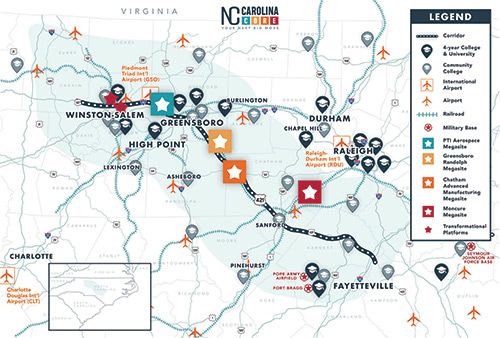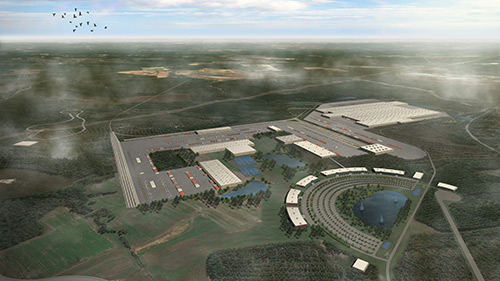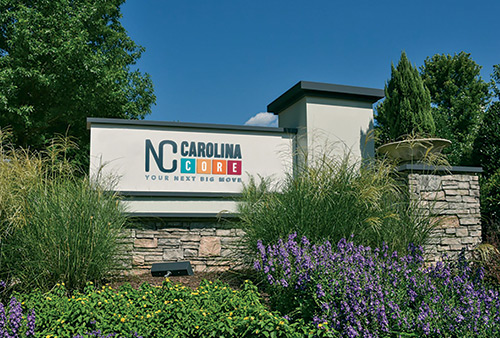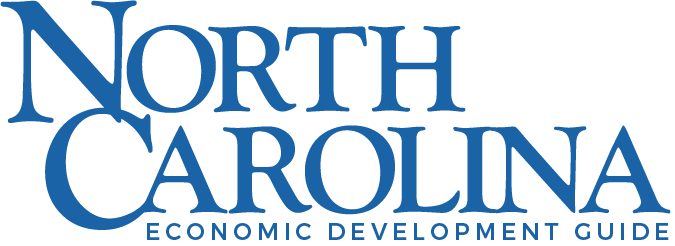Core strength
Piedmont Triad International Airport’s state-of-the-art facilities and available workforce make PTI a catalyst for commercial and industrial development.
Leaders from Fayetteville to Winston-Salem shape a regional strategy for job growth.
Quick look: The Carolina Core initiative takes a broader view of economic development.
By D. Lawrence Bivins
Mapping imagery has long been critical to those involved in promoting business locations. Less common is the savvy to view a geographical patchwork and spot clear opportunities others have missed. Architects of the Carolina Core initiative have successfully accomplished this, piecing together a hodgepodge of human and physical assets to create a compelling rationale for a 21st-century business destination.
“We’re probably only in the second inning here,” says Stan Kelly, president and CEO of the Piedmont Triad Partnership in Greensboro. The organization has a decades-long track record of forging collaboration across county and municipal lines. But rarely has it presented a strategy as sweeping as this attempt to bring 50,000 new jobs to the heart of the Tar Heel State by 2038. Along with the PTP board made up of regional leaders, Kelly came up with the idea, which seeks to reinvigorate the traditional cradle of North Carolina manufacturing.
Though champions of the Core have a long-term vision, the initiative has already yielded results, with 10,000 announced new jobs in the initial year. “These are coming in singles, doubles and triples,” says Kelly, who is quick with baseball metaphors. “In time, we’ll find more triples and ultimately, that home run.”

Carolina Core, located between Winston-Salem and Fayetteville, boasts four megasites with 7,200 acres of certified land that offer advanced manufacturers room to grow. The region includes many other industrial sites, higher education institutions, international transportation, research parks and mixed-use developments. Provided by Piedmont Triad Partnership.
The initiative weaves together four North Carolina megasites: large, accessible swaths of undeveloped land with certification checklists met and modern infrastructure already, or soon-to-be, in place. The sites are in various stages of readiness as local officials work to install industry-grade water, sewer, natural gas, telecommunications and power. Common to all of them is proximity to labor, which is the real competitive differentiator for today’s companies and communities.
“We’re a large region from a workforce and talent perspective,” says Kelly, who spent decades as a banking-industry executive in the Triad prior to assuming leadership at PTP in 2015. About 800,000 people live within 30 miles of Greensboro, he says. Broaden the aperture across a 60-mile radius, and companies have a potential labor pool of more than 2 million. “We have a
lot of workers,” Kelly says of the region.
The blend of physical and human resources comes with a generous dose of leadership and collaboration. With the Carolina Core stretching from Winston-Salem to Fayetteville, there are a host of economic development professionals, elected officials, educational partners, state entities and private allies in the mix. The goal is to unite them around themes of readiness, connectivity, branding and shared reward.
“It’s not traditional regionalism — it’s more strategic,” says Bob Leak Jr., president and CEO of Winston-Salem Business Inc. and a longtime North Carolina economic development leader. “We think of regional programs as place-based,” he says. “The Core is more asset-based.” The group sought something with global resonance. It examined data and studied maps. “We did a very deep dive,” Leak says.
It also sought feedback from location advisers, an influential voice in corporate site decisions. Kelly, Leak and other Core leaders hosted 10 site-selection consultants for lunch in Chicago to gauge their reaction to the strategy. Feedback was encouraging, and the group has requested expertise from Development Counselors International, a New York City-based location-marketing agency, and is moving ahead with advertising, digital promotion, social media platforms and additional consultant outreach. “All of us are looking forward to taking this message out to the rest of the world and letting them know where we are,” Leak says.
While not home to a megasite, Winston-Salem brings formidable assets to Carolina Core efforts, including the 220-acre Whitaker Park, a redeveloped manufacturing complex adjacent to Wake Forest University. One of the South’s most prestigious private universities, Wake Forest has extended its reach beyond the campus into downtown Winston-Salem and the broader region.
Julie Freischlag, dean of the Wake Forest School of Medicine and CEO of Wake Forest Baptist Health, says additional global attention on the Carolina Core will yield new opportunities for Wake Forest in recruiting talented workers, patients and students and developing new partnerships with businesses. The Wake Forest Innovation Quarter supports commercialization of pioneering treatments, merging medical technologies and other health-related startups. “We have a lot of entrepreneurial thinkers,” Freischlag says. “There are a lot of opportunities for companies to work with us.”
When Freischlag, a vascular surgeon by training, arrived at Wake Forest nearly three years ago from the University of California at Davis, she was quickly invited to take a regional leadership role. “Stan [Kelly] invited me to serve on the PTP board the minute I came to town,” she says. Kelly brought her up to speed on a new idea taking shape that would encompass the region’s business assets, including health care expertise and higher education institutions. “I can’t remember him not talking to me about Carolina Core — even when it didn’t have a name,” Freischlag says. With 20,000 employees and a patient service area extending across about half of Carolina Core’s footprint, Wake Forest Baptist’s collaboration was a natural fit. “We’re a health system, and it’s important that we be a part of something like this.” (At press time, Wake Forest Baptist was negotiating a combination with Charlotte-based Atrium Health, the state’s biggest hospital operator.)
In Chatham County, home to megasites in Moncure and Siler City, Alyssa Byrd, president of Chatham Economic Development Corp., works to synthesize the Carolina Core vision with local business-development objectives. The county sits between the manufacturing-rich Triad and technology-oriented assets of the Research Triangle region. “In terms of our demographics, we pick up both Greensboro and Raleigh within 45 minutes,” Byrd says. With automotive equipment-makers and advanced manufacturers at the top of its short list of target industries, Chatham County responded quickly to the invitation to join Carolina Core.
“Automotive is the holy grail,” Byrd says. “But we also make sure we’re responding to the realities of the market.” Assuming a “home run” such as a large manufacturing plant doesn’t materialize, she doesn’t rule out the option of developing the Chatham-Siler City Advanced Manufacturing Site into a more conventional industrial park that would be home to a range of tenants. The 1,818-acre property, which sits partially along a Norfolk Southern Railway line in the county’s northwest, has had technical leadership from Greensboro-based Samet Corp. and Stimmel Associates, an engineering and land-planning firm with offices in Charlotte and Winston-Salem. Funding assistance has come in part from the Rocky Mount-based Golden LEAF Foundation, a state-created nonprofit. Logistics and distribution operations would also work well at the Chatham site, Byrd says.

The 2,500-acre Moncure Megasite is the state’s largest. It’s about 45 minutes from Raleigh, providing convenient access to major universities, community colleges and Research Triangle Park. The Chatham County site is adjacent to Wake, Lee and Harnett counties. Rendering provided by Piedmont Triad Partnership.
Accessibility is the central selling point of the Moncure Megasite, a 2,500-acre property at the southeastern tip of Chatham County being developed and promoted by Raleigh-based NAI Carolantic Realty Inc. Within easy reach of Raleigh, Fayetteville and Research Triangle Park, companies settling at the property can tap a large, well-educated workforce that includes exiting military personnel at Fort Bragg near Fayetteville. With both north-south and east-west mainline rail links, Moncure tenants will have good access to North Carolina’s deepwater ports.
“We’re the geographical center of North Carolina,” says Michael Smith, CEO of the Sanford Area Growth Alliance, also a Carolina Core partner. The city of Sanford, just south of Moncure, extended sewer service to the megasite under a revenue-sharing agreement. “It’s a big deal for us,” says Smith, who came to Lee County in 2018 after spending much of his career in the western Piedmont region. “It’s a pretty dramatic story,” he says of the Carolina Core vision. “When I heard about it, my initial reaction was that it was a great idea that makes a lot of sense.”
Smith says the accessibility advantage of the Carolina Core lies both with its locational edge and its aviation assets. His community is home to the Raleigh Executive Jetport, a corporate aviation facility opened in 2001. Other general aviation airports dot the region, connecting businesses with customers, markets and opportunities. Commercial air transportation also figures into the strategy.
Fayetteville Regional Airport offers passenger service via Delta Air Lines and American Airlines, in addition to extensive fixed-based operations supporting business aircraft. Critical to the Carolina Core strategy is Piedmont Triad International Airport in Greensboro, which can connect passengers with either nonstop or one-stop service to 250 business destinations around the world.
“Air travel is going to be very important for the companies locating at any of the megasites,” says Kevin Baker, executive director of the Piedmont Triad Airport Authority. While serving as North Carolina’s third-largest airport, Piedmont Triad also offers its own megasite to complement the Carolina Core’s assets. A 1,000-acre property is under development that will build on the airport’s impressive lineup of aviation-related tenants. Greensboro is home to aerospace manufacturers, suppliers, and maintenance and service providers, with names such as Cessna Aircraft Co., HondaJet and HAECO Americas leading the list.
FedEx Corp. maintains a busy mid-Atlantic hub that employs more than 1,000 workers at PTI.
Carolina Core dovetails neatly with PTI’s strategic plan to bring Greensboro aerospace- and aviation-service jobs. The airport’s expanded acreage is being equipped with top-grade utilities, including abundant water for the purpose of modern fire-suppression systems and advanced fiber optics. “One of the big needs [of aerospace companies] these days is broadband,” Baker says. Companies deploy virtual engineering teams pulled together from sites around the world, each sending and receiving large data packets. “They rely on big digital pipelines,” he says. Conventional connectivity, however, also remains critical. “We’re blessed with roads, roads and roads,” Baker says. “Our interstates are second to none.”
Upgrading U.S. 421 to “interstate” status is central to the Core’s strategy. The key thoroughfare links each of the four megasites. Much of it already operates as an interstate in all but name — four lanes divided by a broad median, controlled access and quality interchanges. Only a few stretches will require re-engineering. “We’re requesting it be granted interstate status,” says Michael Fox, a Greensboro attorney who chairs the N.C. Board of Transportation. The request is now in the hands of federal officials in Washington, D.C. “It doesn’t happen overnight,” Fox says.
Once complete, U.S. 421 will plug into North Carolina’s busy nexus of industry-grade freeways including I-95, I-40, I-85 and I-77. “We have an incredible confluence of highways,” Fox says. When combined with extensive rail and aviation assets, the region is “a sweet spot as far as transportation goes.”
Highway connections also are key to shuttling large numbers of employees to and from their new jobs. The region’s workforce nearly earned the 1,900-acre Greensboro-Randolph Megasite a big win in the hunt for a $1.6 billion Mazda Toyota manufacturing facility. In early 2018, officials of the Japan-based joint venture announced their selection of Huntsville, Ala., after a national search. More recently, the Greensboro-Randolph Megasite, which sits on U.S. 421 just 10 miles from I-85, was under consideration by the U.S. unit of India’s Mahindra Automotive for a 2,000-job production site, according to news reports.
The headline-generating Mazda Toyota search, dubbed “Project New World,” may turn out to have been a dress rehearsal for future success in North Carolina’s long quest for an automotive-manufacturing plant, according to James Blair, managing director at Navigator Consulting, a location-advisory firm with offices in Atlanta; Jackson, Miss.; and Dusseldorf, Germany. “Greensboro would have been the better choice for automotive because of the labor supply,” Blair says. Though his firm was not involved in the Mazda Toyota effort, he cites the region’s large number of workers skilled across professions automakers typically need, from welding and mechatronics to engineering and logistics. “That area from Raleigh to Greensboro typically runs the gamut.” Blair says he’s being generally impressed with North Carolina’s megasites.
“Our No. 1 asset is workforce,” says N.C. Secretary of Commerce Tony Copeland. Officials from Mazda Toyota’s search team, in fact, conceded as much to Copeland and others. “It came from their data,” he says. But the choice of Huntsville, Ala., boiled down to the company’s desire to be near existing supply chains. “We could find them 3,000 employees to manufacture automobiles,” Copeland says. “What we couldn’t do was move the site 250 miles west.”
Still, optimism is high for the allure of North Carolina’s megasites in landing major names in automotive, aerospace and other prominent industries. “We need to be diligent about working on all these sites to make sure they are as prepared as possible,” says Copeland, who was a site-selection consultant prior to his appointment as commerce secretary in early 2017. Again, it’s a long game. Recent big wins at megasites in Edgecombe and Davidson counties were the result of planning that began in the 1990s. Copeland commends Carolina Core leaders for stepping forward to pull the initiative together. “Leadership is the ability to see the future,” he says. “That’s what they’re doing.”
CORE CAMPUSES
 Breaking down once-thick lines of separation among educational providers and training curricula sets North Carolina apart from competing states, a distinction that leaders of Carolina Core are seeking to maximize as they move ahead with corporate recruitment plans.
Breaking down once-thick lines of separation among educational providers and training curricula sets North Carolina apart from competing states, a distinction that leaders of Carolina Core are seeking to maximize as they move ahead with corporate recruitment plans.
N.C. public schools, based on systematic state funding across communities, give secondary educators flexibility in balancing conventional academic curricula with innovative vocational opportunities such as youth apprenticeships, career and technical training, and early-college high school. “It’s a broad program that makes North Carolina easy to work with,” says James Blair, an Atlanta-based global location adviser with Navigator Consulting. “That’s not something available in every state.”
With campuses in Chatham, Lee and Harnett counties, Central Carolina Community College collaborates with public school systems in each county to create a workforce pipeline capable of filling both current and anticipated employer needs. “We work very closely with our K-12 partners,” Central Carolina President Lisa Chapman says. That includes a unique Career Coaches program that places college advisers in each of the nine high schools in the area. They counsel students in as early as the ninth grade on local career opportunities and the coursework needed to build the qualifications for them.
Central Carolina — like each of North Carolina’s 58 community colleges — offers short-term training programs to meet the skill demands of expanding and arriving companies. In Lee County, the college has met the growing needs of Pfizer Inc., Pentair and Magneti Marelli. Of a 14-student cadre of high school grads who simultaneously completed youth apprenticeships at Caterpillar Inc. in 2019, 12 were hired by the company permanently. “It’s been a great partnership,” Chapman says of the college’s support for the Illinois-based construction-equipment company, which has had a manufacturing site in Sanford since 1999.
Earlier in 2019, Central Carolina entered into a partnership arrangement with Western Governors University North Carolina, which provides competency-based bachelor-degree programs online. The deal provides “articulation” — an agreement to honor inter-college transfer credits — as well as tuition discounts, scholarships, and guidance for the college’s advisers and faculty.
“A partnership with WGU means that a community college can offer a clear pathway to a four-year degree,” says Catherine Truitt, chancellor of WGU North Carolina. Central Carolina is one of eight North Carolina community colleges the university partnered with as of mid-2019. WGU students transferring from community colleges enjoy enhanced prospects for success. “Statistically, students are more likely to finish their bachelor’s degrees if they come to us through a community college,” Truitt says.

